A climate voter’s guide to the L.A. mayoral election
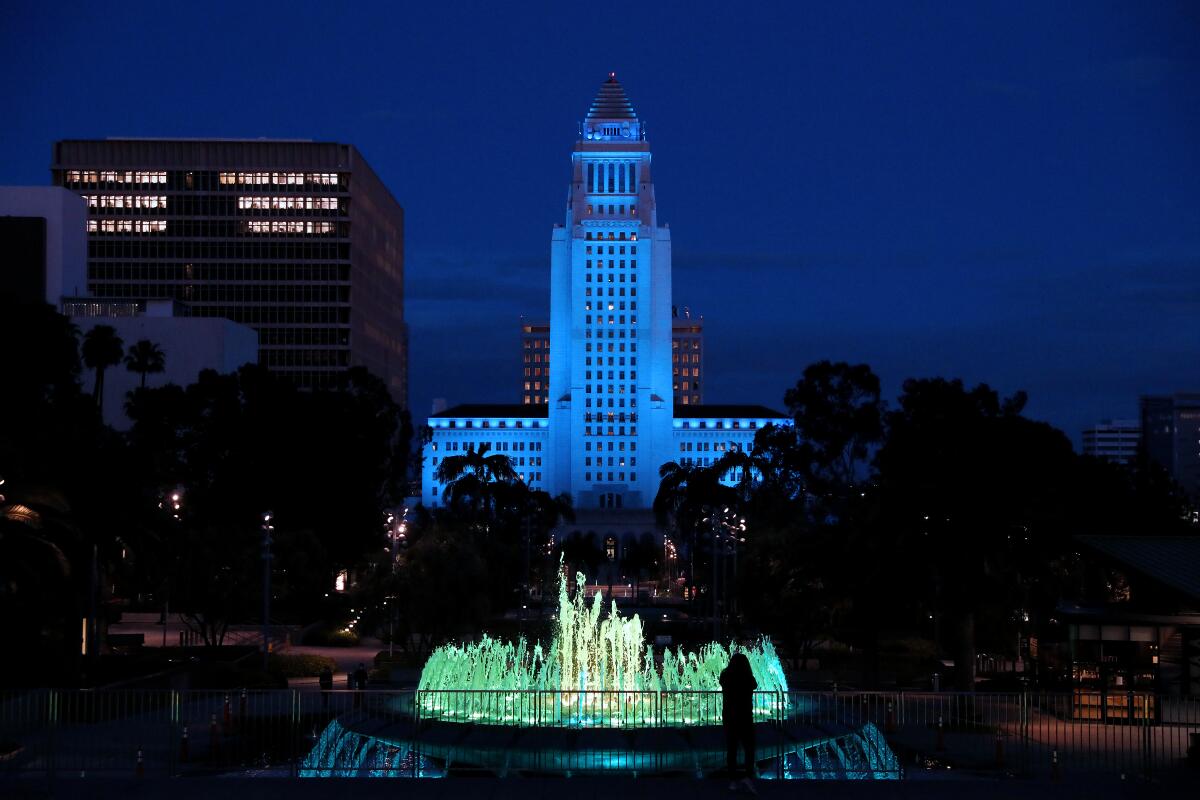
- Share via
This is the April 21, 2022, edition of Boiling Point, a weekly newsletter about climate change and the environment in California and the American West. Sign up here to get it in your inbox.
Eighty-one percent of Los Angeles voters describe air pollution as a serious threat to their health and safety. Sixty-four percent say the same about extreme heat. Big majorities want more public transit, more bus-only lanes, more public parks, more composting and less water-guzzling ornamental grass. Half of L.A. voters support banning gas heating and cooking in new housing.
Those are the findings of a new poll co-sponsored by The Times. Although climate change was far from the top priority identified by Angelenos, it’s clear they’re alarmed by rising temperatures and eager for politicians to act, as I wrote in my story on the poll.
Despite those numbers, the leading contenders for L.A. mayor have barely discussed how they would tackle the climate crisis.
So I asked them.
In exclusive interviews, four of the five highest-profile mayoral candidates — Karen Bass, Joe Buscaino, Kevin de León and Mike Feuer — answered my questions about powering the city with 100% clean energy, expanding public transit, creating safer streets, phasing out gas stoves, slashing water waste and protecting vulnerable Angelenos from heat waves and air pollution. Bass and De León also shared detailed climate plans for the first time, joining Feuer, who released his environmental platform months ago.
I tried my best to get an interview with billionaire developer Rick Caruso, who led a recent poll. But despite reaching out to a representative for his campaign almost two weeks ago — and being told repeatedly that Caruso would find time to talk with me — the interview kept getting pushed back, and ultimately didn’t happen. Instead, the campaign sent me a written statement.
Here’s what the candidates told me, to help inform your vote in the June 7 primary. (The top two finishers will meet in a November runoff, assuming no one exceeds 50% of the vote.) If you don’t live in Los Angeles, feel free to scroll down for a rundown of this week’s news. Or you can read what the mayoral candidates had to say — because what happens in L.A. doesn’t stay in L.A.
Karen Bass
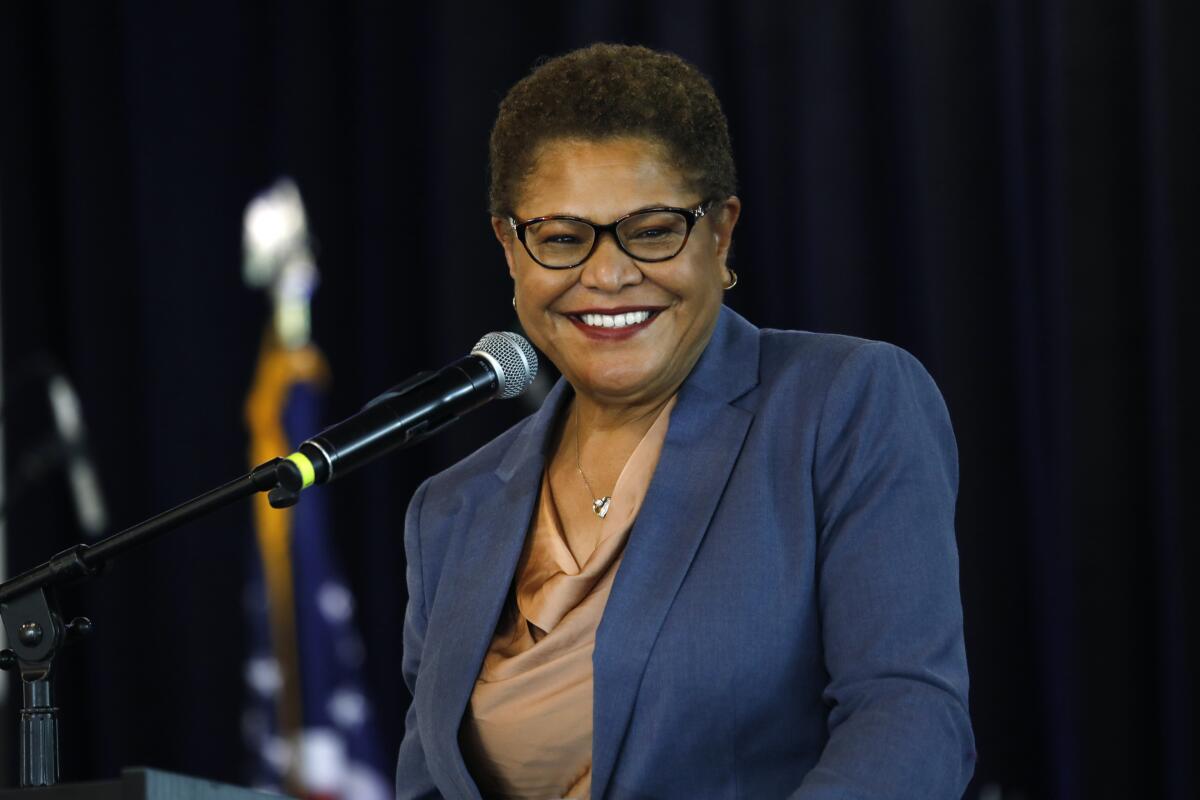
Like all four candidates I talked with, Bass — a congressional Democrat who represents much of the Westside and South L.A. — told me she supports Mayor Eric Garcetti’s goal of 100% clean electricity by 2035, 10 years ahead of state law. The city’s Department of Water and Power has determined that goal is feasible. But the across-the-board support is still pretty remarkable.
Asked how she’ll get the city to 100% clean power — feasible or not, it’s a big lift — Bass didn’t have much to say, pledging to “leverage public dollars” and create green jobs. She pivoted to cleaning up air pollution by electrifying diesel-fueled trucks and equipment at the ports of L.A. and Long Beach, and her work to shut down urban oil extraction sites like Allenco in South L.A.
“I would definitely focus efforts on the communities and the neighborhoods that are really disproportionately impacted,” she said.
Asked about transportation — the city’s largest source of pollution — Bass mentioned switching to electric school buses and offering rebates to help lower-income families buy electric cars. She went into more detail on possible strategies for getting cars off the road, such as taking advantage of the work-from-home boom and staggering in-person schedules for office workers, much as Los Angeles did to reduce freeway congestion during the 1984 Olympics. She also called for for better-protected bike lanes.
“I’m a bike rider. But I will tell you that I don’t ride on the streets,” she said. “I think it’s too dangerous to [bike] in traffic.”
On protecting Angelenos from heat waves — which are getting hotter and more deadly as the planet warms — Bass cited the “promotores de salud” model of community health workers in Spanish-speaking communities, and said she would coordinate outreach with “the community clinics who know the populations and know the people who are the most vulnerable.”
She also understated the dangers of extreme heat. Elderly people dying in their homes, she said, “has historically been a problem in Chicago,” and “I don’t think L.A. is to that point.” Although Chicago has seen horrible heat waves, a recent Times investigation found that heat killed an estimated 3,900 Californians during the last decade — with people over age 65 at especially high risk.
On transitioning homes from gas boilers and stoves to electric appliances — a proposal is circulating at City Council — Bass expressed support but said it’s important to keep electricity bills under control. On water and drought, she supports Garcetti’s goal of reducing imports from the Colorado River and the Owens Valley, and sourcing 70% of the city’s water locally by 2035. But she’s skeptical about requiring the removal of ornamental grass from street medians and business parks, like Las Vegas recently did.
There were several topics Bass acknowledged not having much to say about, including the L.A. River. She also expressed pride that California is “so far ahead of the rest of the country” on climate, which many advocates and experts say is no longer true.
Bass was recently endorsed by the Sierra Club, which called her “an early endorser of the Green New Deal.” Her environmental plan is incredibly detailed. And she’s likely to make the November runoff, with a recent poll putting her in a dead heat with Caruso.
I also spoke with Fran Pavley, a former state lawmaker who wrote landmark climate bills and worked with Bass for years. She told me that although climate was never Bass’ top priority, “she always hired the best people to implement and support those issues.”
Joe Buscaino

The L.A. City Council member — who has a reputation as a pro-business moderate — told me climate would be one of his top three priorities, along with homelessness and crime. His district includes the neighborhoods surrounding the Port of Los Angeles, which suffer from some of the nation’s worst pollution. He vowed to clean up that pollution and create a zero-emission port by 2035.
“I was born and raised in San Pedro. I grew up in a home on Alma [Street] overseeing the port,” he said. “I’ll never forget as a kid growing up seeing plumes of black smoke coming out of the [oil] refineries to the north. I’ll never forget stories of my uncles and aunts and friends and cousins who worked the port, and said after a shift they would come home with soot on them.”
Buscaino has touted his eight-plus years on the board of the South Coast Air Quality Management District, saying he worked to reduce lung-damaging pollution through new regulations, investments in cleaner trucks and solar panels on warehouses.
But he faced constant criticism from community activists, who said he too often opposed aggressive clean-air rules and sided with weaker, industry-backed proposals. The group East Yard Communities for Environmental Justice once called him “pro-polluter.”
Much of the debate at the nation’s busiest port complex revolves around whether to require investment in electric trucks, which are still relatively costly and unproven, or instead promote the use of natural gas, a fossil fuel that’s much cleaner than diesel but still contributes to air pollution and the climate crisis. Buscaino called natural gas “a steppingstone,” expressing frustration with activists who want to see the ports hold out for electric trucks “while people are dying from cancer and suffering from asthma.”
“At least for now, let’s use natural gas, knowing that it will be a lot healthier than what what you’re seeing today,” he said.
Asked about City Councilmember Nithya Raman’s proposal to phase out gas heating and cooking, Buscaino said he’s “open to it” but wants to make sure the transition to all-electric homes doesn’t increase housing costs. He also said the city must make sure it has enough electricity to power homes and businesses that ditch natural gas, as well as a growing fleet of electric vehicles.
“We can’t shut down power plants and create more demand for power,” he said. “I’m going at this with a sense of balance.”
Buscaino suggested offshore wind turbines could help L.A. replace gas-fired power plants and reach 100% clean energy by 2035. He also mentioned his role in securing $35 million for affordable housing, solar panels and other clean-energy programs in Watts.
To help people drive less, Buscaino called for a “free and safe public transportation system,” citing a recent Metro survey that found many riders want to see more police or other security on rail lines. On the dangers of extreme heat, he mentioned cool pavement as a solution but mostly called for state and federal action on climate change, saying “the city can only do so much.”
Like Bass, Buscaino didn’t have much to say about the L.A. River. He endorsed Garcetti’s plan to reduce water imports by investing in local stormwater capture and wastewater recycling, and said he might declare a state of emergency as part of an effort to boost water supplies. He sees seawater desalination, an environmentally controversial technology, as one possible drought solution.
Rick Caruso
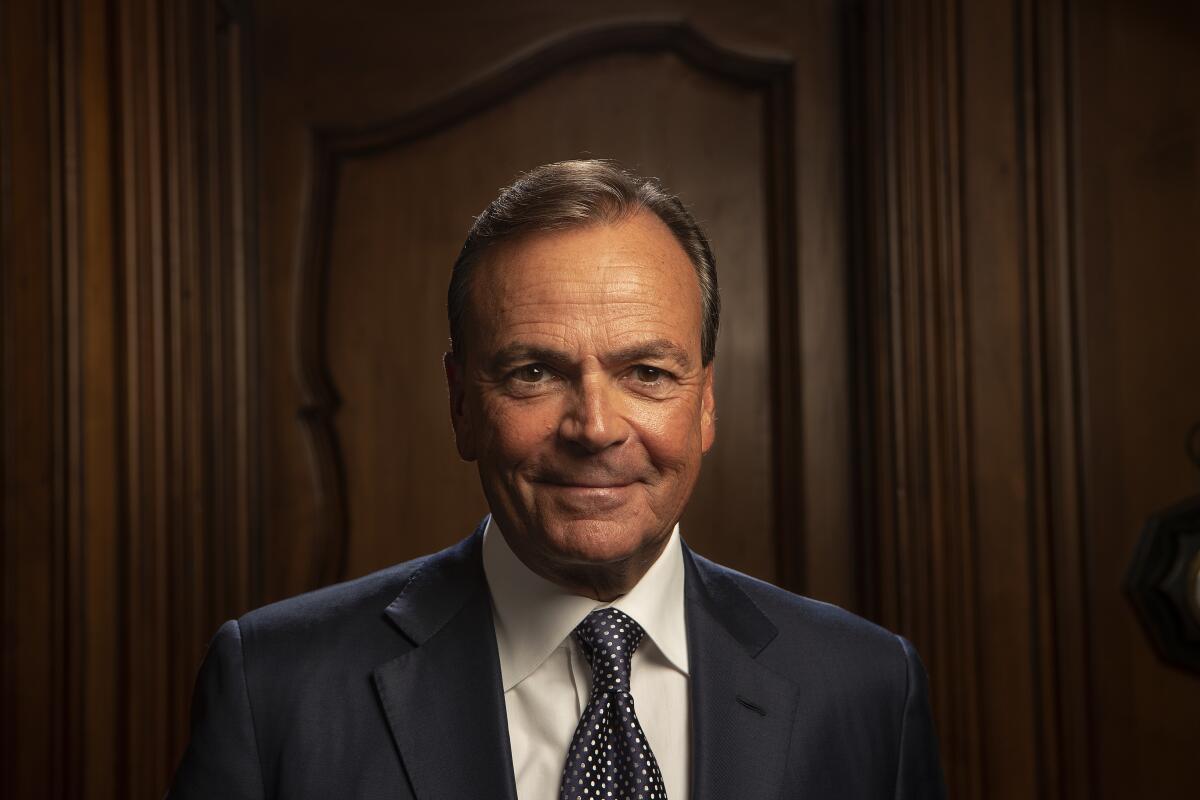
In an emailed statement late Wednesday, Caruso said if he’s elected mayor, the urgency of climate change “will be reflected in policies that meaningfully move us away from our overdependence on fossil fuels and prioritize the needs of communities that have suffered the most from environmental injustice.” He pledged to release a “comprehensive climate plan” in the coming weeks.
He touted his tenure as president of the L.A. Department of Water and Power’s board of commissioners from 1997 to 2000, during which time the agency launched the “Green Power for a Green L.A.” initiative to boost renewable energy, supplied efficient lightbulbs to low-income households and approved millions of dollars in incentives for residents to install rooftop solar panels.
He also provided a long list of sustainability efforts at the malls and other properties he’s developed, including Palisades Village, which he called “the first ground-up, mixed-used business district in California that was certified LEED Gold.”
Kevin de León
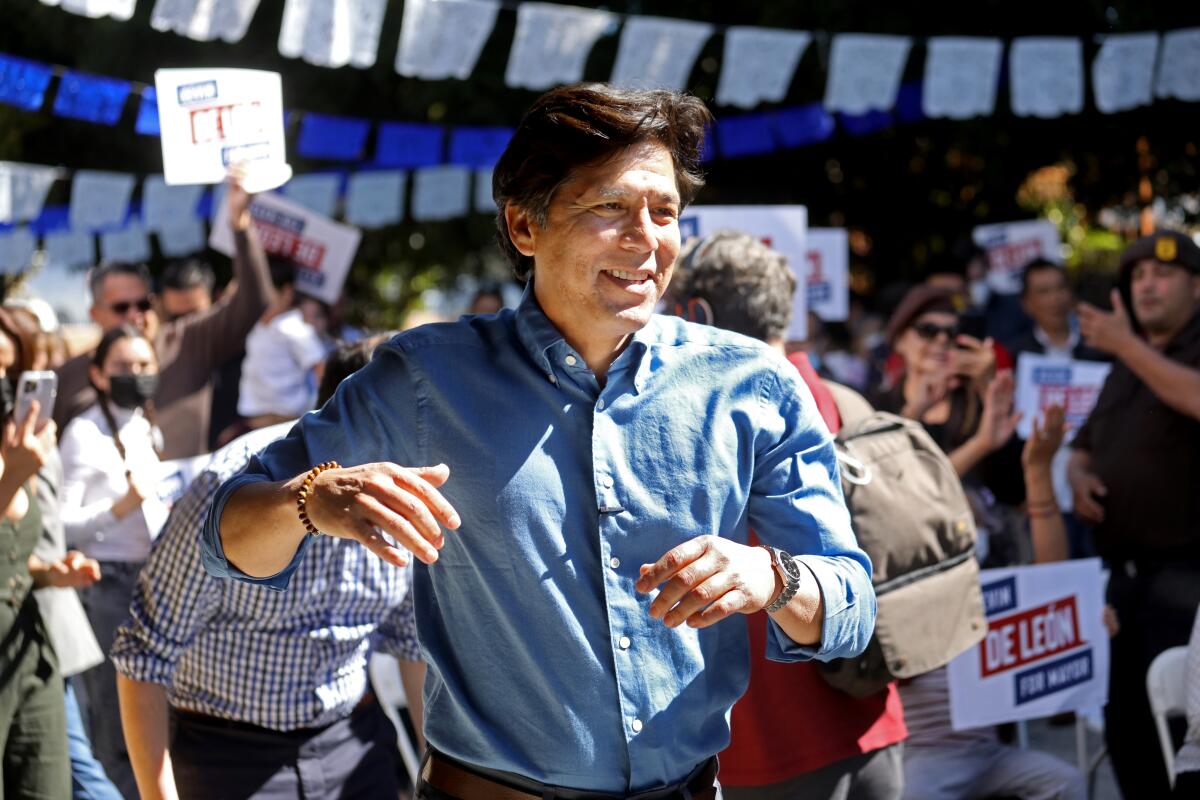
As leader of the California Senate, De León wrote and secured passage of Senate Bill 350, requiring the state to generate half its power from renewable sources such as solar and wind by 2030. Two years later, he introduced SB 100, upping the ante to 100% climate-friendly electricity by 2045, and got it passed despite stiff opposition. He now supports 100% clean power by 2035 in L.A.
So I asked De León why — on an issue central to his political career — he’s been relatively quiet while on the campaign trail.
De León, who now serves on City Council, told me he’s brought up climate and air pollution several times at mayoral debates despite not being asked about it by the moderators. He then established his environmental bona fides by listing the nine freeways that run through his district, which covers parts of downtown and northeast L.A.: the 2, 5, 10, 60, 101, 110, 134, 210 and 710.
Pollution “kills more people in neighborhoods like Boyle Heights, San Pedro, Wilmington, Pacoima and Watts than anywhere else,” he said. “What’s the point of having the best weather on planet Earth if we need an inhaler just to go outside and enjoy it?”
To clean up transportation, De León called for electrifying buses and Metrolink passenger trains and making “historic investments” in electric car chargers. He set a goal of 3,000 fast-charging stations in the city — more than the 2,900 gas pumps he said L.A has today. He said these types of investments would create green jobs, “disrupting altogether the school-to-prison pipeline.”
At the ports of L.A. and Long Beach, De León called for an aggressive transition to electric trucks and other clean equipment. He didn’t dismiss natural gas as an interim solution, though, saying, “We can’t always let the perfect get in the way of the good.”
De León said he’d work toward safer public transit and eliminate fares for people 25 and younger. He expressed optimism that funding from voter-approved Measure M would help L.A. County build a “ubiquitous” transit system that works for all Angelenos — not just working-class janitors, hotel staff and security officers who depend on buses and trains today, but also wealthier people.
He also said he’d take great care in choosing appointees to the Metropolitan Transit Authority and DWP boards, and “work very closely with our labor friends to make sure that we’re all on the same page” — a key point, since workers at DWP and Southern California Gas Co. have at times fought the transition away from fossil gas. On the question of phasing out gas heating and cooking, De León said he generally favors moving toward all-electric homes but hasn’t read Raman’s City Council motion yet.
On extreme heat, De León said he would “bust up the concrete, the cement and asphalt, particularly in poor neighborhoods, where they have little to no trees for canopy to lower hellaciously hot temperatures.” He said he’d work to build more green spaces, citing his authorship of several bills that resulted in hundreds of millions of dollars in funding for parks in L.A. and across the state.
“We can move heaven and earth to build football stadiums,” he said. “We can do the same thing to greenify the city of L.A.”
Asked about drought, De León said he supports cutting back on water imports and would emphasize “conservation, conservation, conservation” — even when it starts to rain again. He sidestepped a question about whether the city should require ornamental grass to be removed. But he did say L.A. should make sure incentives to tear our front lawns are distributed more equitably.
Mike Feuer
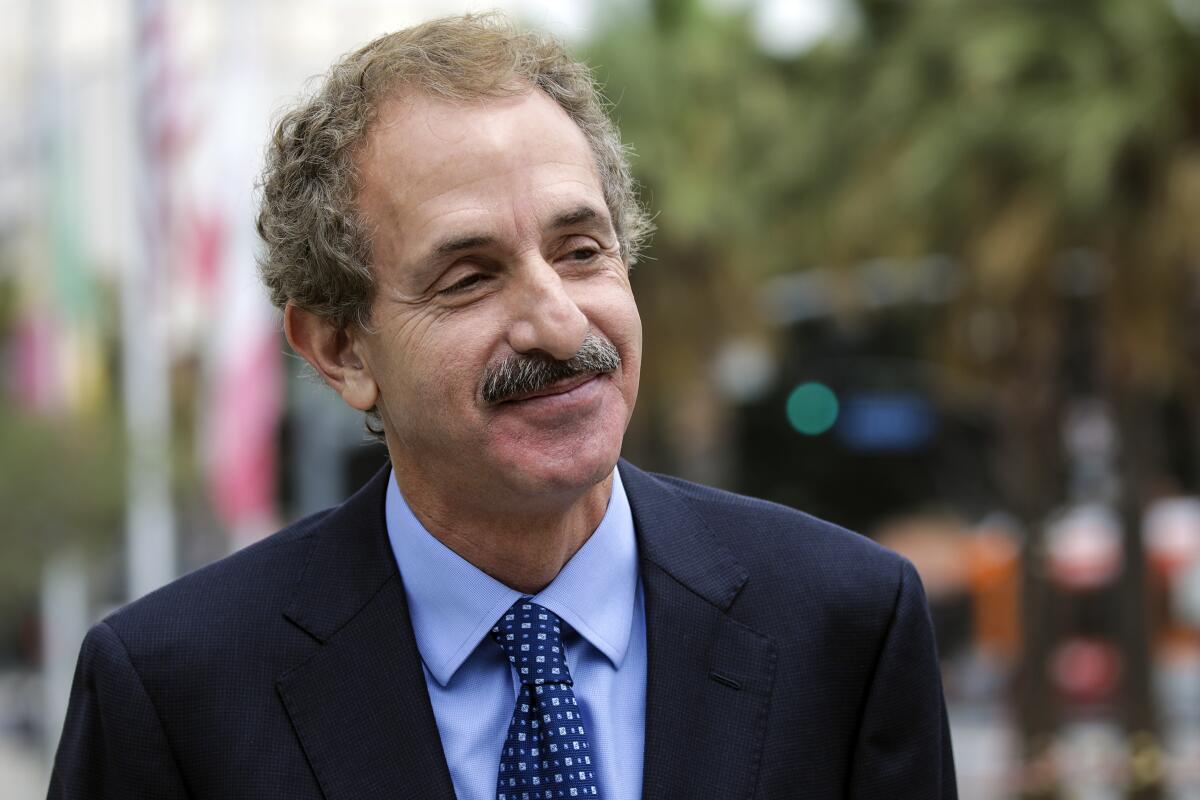
Feuer has served as L.A. city attorney since being elected in 2013. His website lists several environmental accomplishments, including suing SoCalGas over the Aliso Canyon methane leak and writing a bill when he served in the state Legislature requiring a 20% reduction in per-person urban water use. That target became law after being incorporated into a larger conservation bill.
Feuer quickly endorsed Garcetti’s goal of 100% clean energy by 2035, and he told me he’d set “firm benchmarks” to make sure there’s sufficient progress during his two terms as mayor. He said reaching that goal would require “a further effort” to expand rooftop solar power, and to make sure solar and battery storage are accessible to all communities — a key point, since the National Renewable Energy Laboratory study mapping the city’s path to 100% clean energy assumes a huge expansion of rooftop solar.
As for gas heating and cooking, Feuer said he supports phasing them out of new housing, while listening closely to the concerns raised by SoCalGas workers. He also said he’d back a a “subsidy-style program” to replace gas appliances in existing homes.
“The gas company’s business model is not my major concern. My major concern is having a survivable planet,” he said.
On public transit, Feuer articulated a similar big-picture vision to the other candidates — make streets safer and easier to navigate for bikes and buses, expand and electrify light rail — along with a bunch of nitty-gritty ideas, such as installing digital screens at bus stops that tell riders when the next bus is coming, and upgrading seat covers on trains as part of an effort to make transit cleaner, safer and more welcoming. He mentioned the ongoing construction of a Metro line between downtown and the Westside.
“If we build that and people are reluctant to come, it will be one of the hugest tragedies in the history of our city,” Feuer said.
Asked how he would push some of those initiatives through a City Council that’s often hostile to redesigning streets for the benefit of buses and bikers — which can limit parking and slow drive times — Feuer said the mayor “needs to be an assertive leader.”
“That abdication of responsibility has a been a huge factor in deterioration of public service in the city,” he said.
Feuer offered a similar mix of big-picture proposals and specific ideas for electric vehicles. He said he’d get more charging stations installed at the airport and in “every community in the city”; reduce emissions at the ports via electric trucks and solar power; and push for cleaner fuels for ships that dock at the ports, building on a partnership between L.A. and Shanghai. He also called for phasing out oil production in disadvantaged communities, although he acknowledged this could be expensive for the city.
Asked about heat waves, Feuer pledged to plant trees, add cool pavement and make cooling centers more accessible. On drought, he said he’d work to obtain 75% of L.A.’s water from local sources such as groundwater and recycling by 2035, up from Garcetti’s goal of 70%. Like other candidates, he doesn’t think the city should require ornamental grass to be torn out — at least not yet.
One other thing: If Los Angeles recycles more wastewater — which basically everyone in city government supports — there will be less water in the L.A. River, since wastewater treatment plants are currently one of its primary sources of flow. Feuer said he dreams of a river that has “bike lanes and walking and is greened and has lighting. It has restaurants that face onto the river.” But, he acknowledged, he hasn’t yet “figured out how to reconcile the tension” with wastewater recycling. He’s not alone on that.
Other candidates
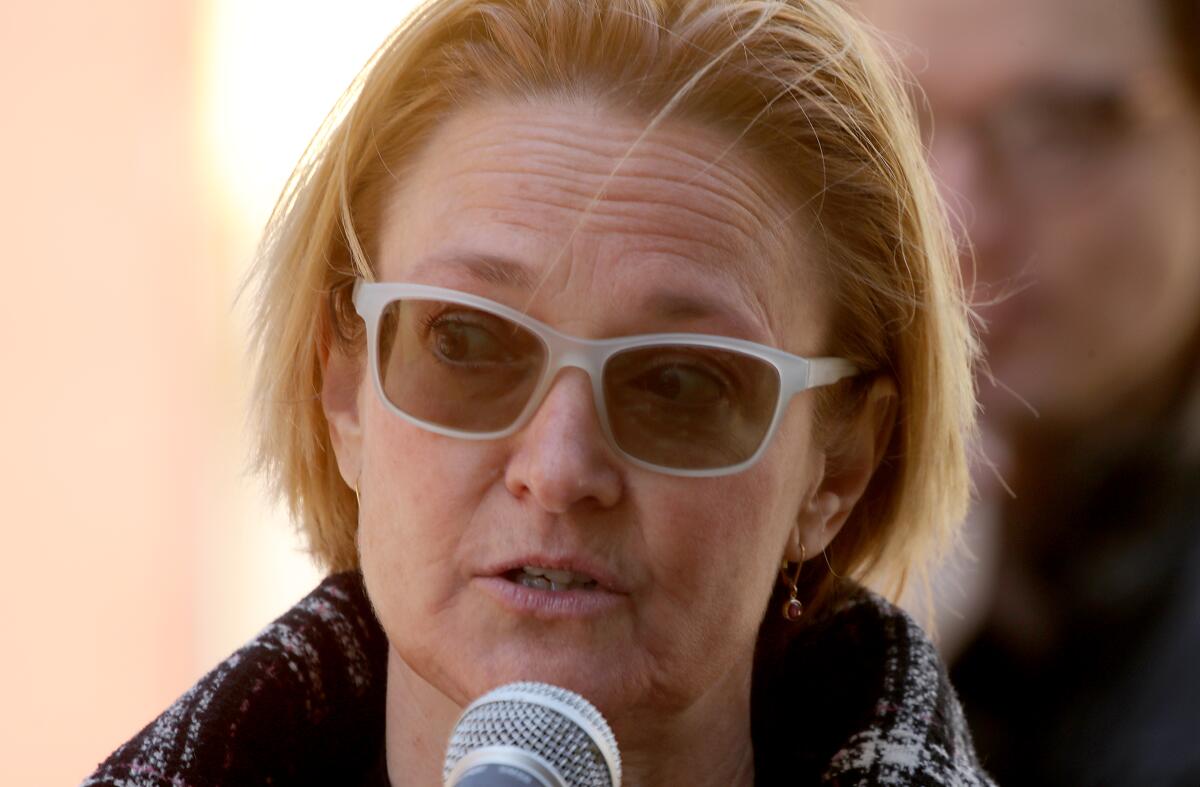
Bass, Buscaino, Caruso, De León and Feuer were the five participants in the most recent mayoral debate, but they’re not the only people running to replace Garcetti. Four other candidates — Craig Greiwe, Alex Gruenenfelder, Gina Viola and Mel Wilson — are demanding to be part of the next debate, saying organizers have unfairly excluded them and limited their ability to reach voters.
Viola — who recently polled at 2%, tied with Feuer and ahead of Buscaino — has embraced the Sunrise Movement’s Green New Deal and was endorsed by Youth Climate Strike Los Angeles. She also supports the “25x25” plan to repurpose 25% of the land area currently dedicated to driving and parking by 2025, to create more protected bike lanes, parks and other climate-friendly spaces.
Wilson, too, has focused on the environment, releasing a climate plan and saying he’d like to highlight the issue at the next debate. Greiwe discusses climate on his website. Gruenenfelder was also endorsed by Youth Climate Strike Los Angeles.
So there are your choices for mayor. It’s not too late to register to vote before the June 7 primary.
And now, here’s what’s happening around the West:
TOP STORIES
If you read just one long story this week, make it our wild investigation into the International Seabed Authority, a United Nations-affiliated organization that regulates deep-sea mining. Critics say it’s become an industry shill as companies make plans to extract cobalt, nickel and other minerals crucial for electric-car batteries from the deep ocean. Reporters Todd Woody and Evan Halper scrutinized the authority’s secretary-general, Michael Lodge, and what critics say is his disregard for the potential environmental consequences of disrupting still-mysterious deep-sea ecosystems, which sustain enormous amounts of life.
The California Air Resources Board plans to require that 35% of new cars and trucks sold in the state be zero-emission by 2026, and 68% by 2030. The proposed regulation would help achieve Gov. Gavin Newsom’s goal of no new gasoline vehicle sales by 2035, and would be an enormous boon for electric cars, my colleague Russ Mitchell reports. Russ also wrote about Elon Musk’s strange bid to buy Twitter, writing that if Musk’s leadership of Tesla is any precedent, his promises of “free speech” and transparency for the social media site might not come true. And speaking of Tesla, Pacific Gas & Electric just added 182.5 megawatts’ worth of Tesla batteries to its already-huge energy storage station at Moss Landing, the Associated Press reports.
The Biden administration will auction off public lands to oil and gas companies for the first time this June, with lease sales scheduled in Colorado, Montana, Nevada, New Mexico, North Dakota, Utah and Wyoming. As Jonathan P. Thompson notes in his Land Desk newsletter, Interior Secretary Deb Haaland has implemented a series of reforms to the leasing process, including a big increase in the royalty rates paid by fossil fuel companies and more robust public input on which lands are leased. The Bureau of Land Management also reduced the amount of public land it’s putting up for auction from 733,000 acres to 144,000 acres, with just 160 acres on the drilling block in Utah, as Brian Maffly reports for the Salt Lake Tribune. Federal officials say they’ve got no choice but to hold lease sales following a judge’s ruling, but climate activists see it as a betrayal of Biden’s campaign promise.
POLITICAL CLIMATE

California Insurance Commissioner Ricardo Lara is calling out insurance companies for the $536 billion they’ve invested in fossil fuels. The Times’ Jaimie Ding has the details on a new report from Lara’s office, which found that the insurer with the highest percentage of assets exposed to fossil fuels, at 75%, is a small firm that’s part of Warren Buffett’s Berkshire Hathaway empire. In other fossil fuel accountability news, the Inland Empire city of Fontana approved rules to reduce air pollution from warehouses — but only after getting sued by California’s attorney general, Rob Bonta, The Times’ Tony Briscoe reports. There’s plenty of work left to do to clean up pollution in communities of color especially, with a recent study finding that historically redlined neighborhoods have nearly twice as many oil and gas wells as neighborhoods that were considered “desirable,” as Grist’s Julia Kane reports.
Sixteen young people are suing Montana over the state’s support for fossil fuels, arguing officials are prioritizing industry profits over a livable climate. The case is on track to be the first youth-led climate lawsuit to go to trial in the United States, Ray Levy Uyeda writes for the Guardian. In other Montana news, Talen Energy — which operates and co-owns one of the largest remaining coal plants in the American West— is reportedly preparing for bankruptcy, per Tom Lutey at the Billings Gazette.
Californians will get a chance to limit single-use plastics on the ballot this November — unless the state Legislature passes a law to do it first. That’s where the plastics industry is trying to exert its influence, my colleague Susanne Rust reports. Susanne also wrote about Los Angeles County becoming the biggest jurisdiction in the country to restrict single-use plastics, passing a new rule this week that will require restaurants to supply take-out food containers and utensils that are compostable or recyclable.
WATER IN THE WEST
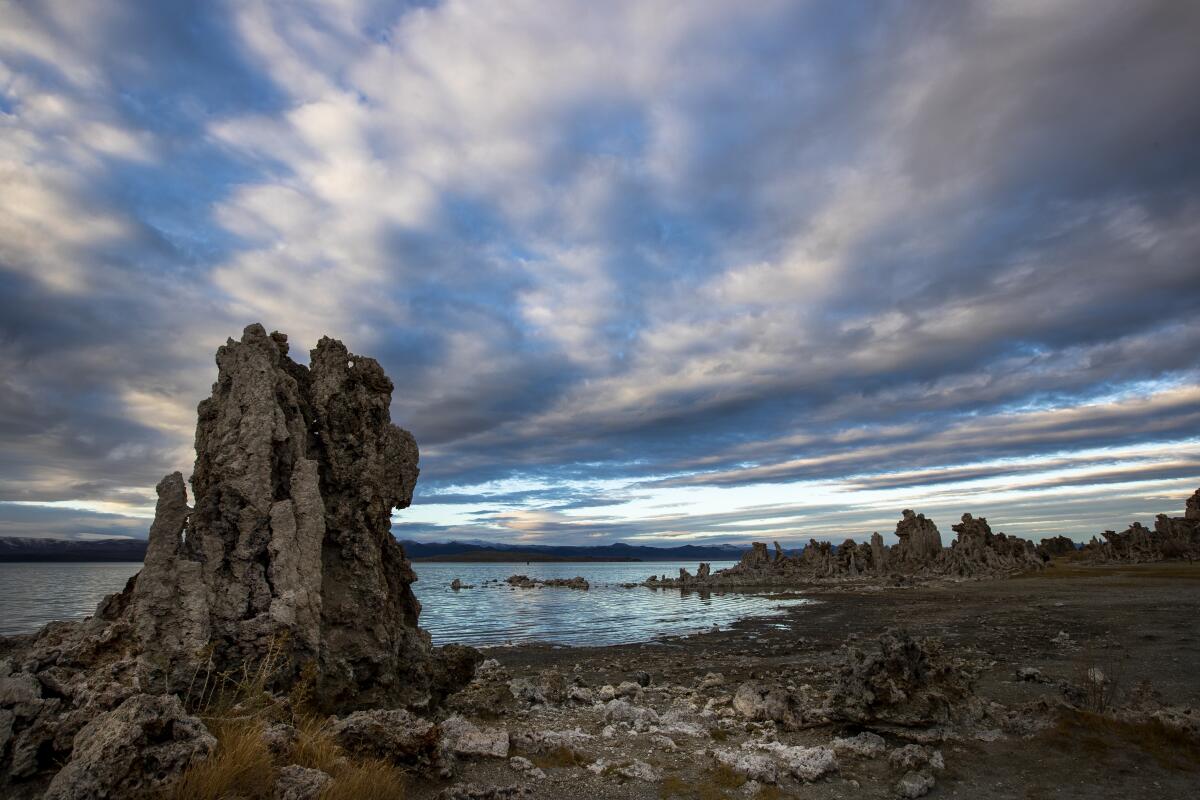
Los Angeles is under orders to take dramatically less water this year from the Sierra streams feeding Mono Lake, as drought and climate change trigger mandatory cutbacks. Here’s the story from The Times’ Louis Sahagún and Ian James, who write that critics say the L.A. Department of Water and Power hasn’t done enough to reduce its reliance on the super-salty high desert lake. Meanwhile, another ailing California lake — Tule Lake, up near the Oregon border — is expected to dry up completely for the first time this summer as much of the little available water is diverted to farms. Tule Lake is home to two endangered fish and serves as a critical stopover for migratory birds on the Pacific Flyway, Kurtis Alexander writes for the San Francisco Chronicle.
The advocacy group American Rivers released its annual report on the nation’s most endangered rivers. It’s an inherently subjective ranking, but still an interesting window into which rivers face environmental challenges — and political opportunities — over the coming year. Not too surprisingly, the drought-stricken Colorado River topped the list this year, as Colorado Public Radio’s Michael Elizabeth Sakas reports. (See also this fascinating piece by Jonathan P. Thompson looking back at the time epic flooding on the Colorado threatened to bring down Glen Canyon Dam, not even 30 years ago.) Southern California’s Lower Kern River also made the “most endangered” list at No. 7; state officials are currently debating whether farmers and cities should leave more water in the Kern, Lois Henry explains in the Bakersfield Californian. The Los Angeles River helped round out the list at No. 9.
Companies are preparing to extract lithium at the Great Salt Lake, and Utah lawmakers want to make sure all that mining generate money to restore the shrinking body of water. More details here from Leia Larsen at the Salt Lake Tribune, who writes that most soda cans in the U.S. contain magnesium harvested from the lake, and most produce was grown with potash fertilizer produced from its waters — which is definitely news to me. And if the lithium story sounds familiar, you may be thinking of similar efforts to extract lithium from the salty waters deep beneath California’s Salton Sea. Those efforts got a boost this week with a company’s announcement that it hopes to build an electric-vehicle battery factory in the area, although nothing is guaranteed.
CLIMATE AND ENVIRONMENTAL JUSTICE
This probably won’t surprise too many of you, but just because the desert is already hot doesn’t mean it’s immune to the dangers of a hotter planet. A new study led by a University of Arizona researcher found that 60% of global cactus species face a heightened risk of extinction by midcentury; here’s the story by the New York Times’ Raymond Zhong (who notes that some cactuses are also found in rainforests, or cool climates). Elsewhere in the desert, a majority of Nevada residents say climate change affects them on a daily basis, with wildfires and smoke some of the primary culprits, per Amy Alonzo at the Reno Gazette-Journal.
Not far from the Coachella music festival, which continues this weekend, Latino families are living in trailer parks with polluted drinking water, including astronomically high arsenic levels. The Desert Sun’s Janet Wilson and Eliana Perez lay out the shocking details, talking with farmworkers and their families and asking government officials why they haven’t done more.
Dos Rios Ranch Preserve, at the confluence of the Tuolumne and San Joaquin rivers, is California’s largest floodplain restoration project. It’s part of a sea change in which some rivers are being allowed to breathe again, restoring habitat and reducing flood risk as climate change fuels more intense rainstorms, as Kathleen Ronayne writes in a thoughtful story for the Associated Press. A different kind of water infrastructure is taking shape in San Jose, where the Army Corps of Engineers and other agencies just broke ground on a $545-million project to protect the city from rising seas, per Paul Rogers at the Mercury News.
YES, I KNOW IT’S EARTH DAY
Generally speaking, I’m one of those “every day should be Earth Day” people. But I recognize the value of having a unique moment every April 22 to focus special attention on saving the planet, and I enjoyed this episode of The Times’ daily podcast, in which host Gustavo Arellano asked several members of our environment team why we should still care about Earth Day. I also loved this edition of our outdoors newsletter, The Wild, in which Mary Forgione suggested 22 things to do in and around L.A. on Earth Day.
ONE MORE THING
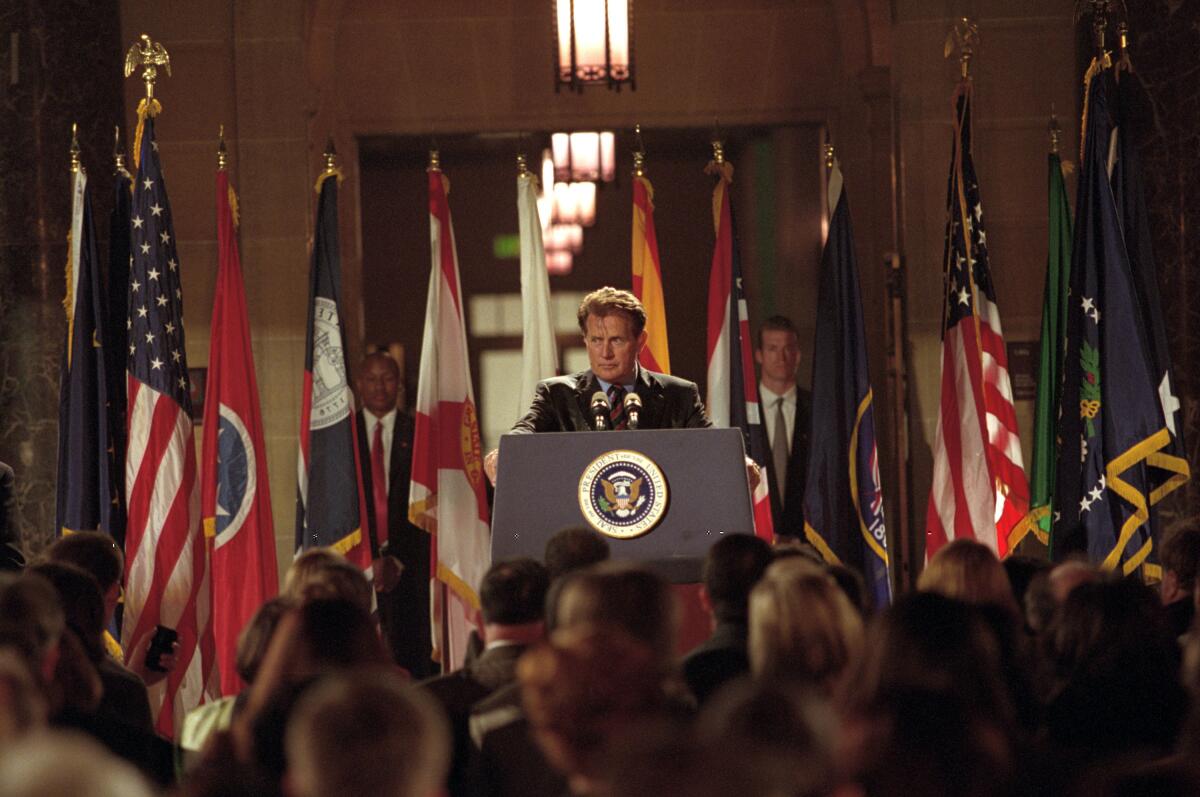
I watched a sixth-season episode of “The West Wing” this week, and I was fascinated by several scenes focused on energy — including renewables. The episode aired in 2004, and in retrospect it got lots of stuff wrong. The characters were worked up about the U.S. running out of oil, which definitely hasn’t happened and won’t anytime soon. Climate change was hardly referenced.
But other parts of the episode were weirdly prescient.
One character complained that wind turbines were an eyesore — still a barrier to the technology’s growth today, as I wrote last year. A hydrogen advocate was confronted with concerns about the fuel’s explosive nature — yep, still a concern today. White House staffers debated the politics of vehicle fuel-efficiency standards and ethanol — both of which are still political footballs.
Overall, the episode struck a pessimistic tone on clean energy. The writers definitely didn’t foresee wind turbines producing more electricity than coal plants (which happened for the first time on record in the U.S. March 29), or California getting 97.6% of the power on its main electric grid from climate-friendly sources, even for a brief moment (which happened April 3, setting a record).
Still, continuing to scale up clean power won’t be easy. Just watch the “West Wing” scene where a solar advocate argues the nation’s energy needs could be met by blanketing 85,000 square miles of the desert Southwest with solar panels. In a preview of the land-use battles playing out today, another character responds, “Your cells will look attractive covering the Grand Canyon.”
No one wants to build a solar farm over the Grand Canyon. But the environmental battles are real. More to come from me on that.
For the record:
5:00 p.m. April 25, 2022An earlier version of this article referred to Aaron Sorkin’s involvement in the sixth season of “The West Wing.” Sorkin left the show after the fourth season.
We’ll be back in your inbox next week. If you enjoyed this newsletter, please consider forwarding it to your friends and colleagues.




